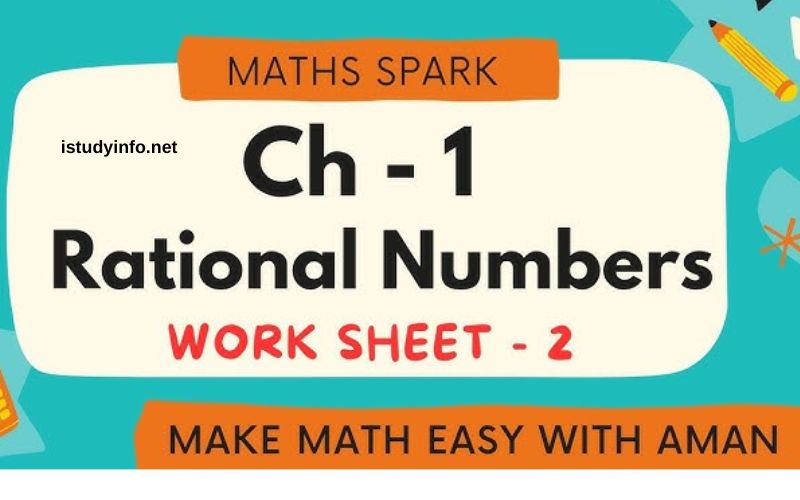Rational numbers form an essential part of mathematics and are crucial for students to understand as they delve deeper into the subject. A rational number is any number that can be expressed as the quotient or fraction pq\frac{p}{q} of two integers, where pp (the numerator) and qq (the denominator) are integers, and q≠0q \neq 0. The word “rational” comes from the word “ratio,” highlighting the fundamental concept that these numbers are ratios of integers.
Properties of Rational Numbers
Before diving into worksheets and exercises, let’s review some critical properties of rational numbers that Class 8 students need to grasp:
- Closure Property: Rational numbers are closed under addition, subtraction, multiplication, and division (except by zero). This means that performing these operations on any two rational numbers will always result in another rational number.
- Commutative Property: Rational numbers follow the commutative property for addition and multiplication, which means:
- a+b=b+aa + b = b + a
- a×b=b×aa \times b = b \times a
- Associative Property: Rational numbers also follow the associative property for addition and multiplication:
- (a+b)+c=a+(b+c)(a + b) + c = a + (b + c)
- (a×b)×c=a×(b×c)(a \times b) \times c = a \times (b \times c)
- Distributive Property: Multiplication over addition for rational numbers follows the distributive property:
- a×(b+c)=(a×b)+(a×c)a \times (b + c) = (a \times b) + (a \times c)
- Identity Element: For addition, the identity element is 0, since a+0=aa + 0 = a. For multiplication, the identity element is 1, since a×1=aa \times 1 = a.
- Inverse: Every rational number has an additive inverse (negative) and a multiplicative inverse (reciprocal), except zero, which does not have a reciprocal.
Converting Between Forms
Students should be comfortable converting between different forms of rational numbers, including fractions, decimals, and percentages. Understanding the equivalence of these forms is vital for solving various mathematical problems.
- Fraction to Decimal: Divide the numerator by the denominator.
- Example: 34=0.75\frac{3}{4} = 0.75
- Decimal to Fraction: Write the decimal as a fraction with 1 as the denominator and then multiply both numerator and denominator by 10 to the power of the number of decimal places.
- Example: 0.75=75100=340.75 = \frac{75}{100} = \frac{3}{4}
- Fraction to Percentage: Multiply the fraction by 100.
- Example: 34×100=75\frac{3}{4} \times 100 = 75%
- Percentage to Fraction: Divide the percentage by 100 and simplify.
- Example: 7575% = \frac{75}{100} = \frac{3}{4}
Operations on Rational Numbers
Addition and Subtraction
To add or subtract rational numbers, follow these steps:
- Find a Common Denominator: Determine the least common denominator (LCD) for the fractions involved.
- Convert Fractions: Convert the fractions to equivalent fractions with the LCD.
- Perform the Operation: Add or subtract the numerators and keep the common denominator.
- Simplify: Simplify the resulting fraction if possible.
Example:
Add 23\frac{2}{3} and 45\frac{4}{5}:
- The LCD of 3 and 5 is 15.
- Convert 23\frac{2}{3} to 1015\frac{10}{15} and 45\frac{4}{5} to 1215\frac{12}{15}.
- Add: 1015+1215=2215\frac{10}{15} + \frac{12}{15} = \frac{22}{15}.
- Simplify: 2215\frac{22}{15} is already in its simplest form.
Multiplication and Division
Multiplying and dividing rational numbers involves straightforward procedures:
Multiplication:
- Multiply the numerators.
- Multiply the denominators.
- Simplify the resulting fraction.
Example:
Multiply 23\frac{2}{3} by 45\frac{4}{5}:
23×45=2×43×5=815\frac{2}{3} \times \frac{4}{5} = \frac{2 \times 4}{3 \times 5} = \frac{8}{15}.
Division:
- Multiply the first fraction by the reciprocal of the second fraction.
- Simplify the resulting fraction.
Example:
Divide 23\frac{2}{3} by 45\frac{4}{5}:
23÷45=23×54=2×53×4=1012=56\frac{2}{3} \div \frac{4}{5} = \frac{2}{3} \times \frac{5}{4} = \frac{2 \times 5}{3 \times 4} = \frac{10}{12} = \frac{5}{6}.
Worksheet Problems
Section A: Basic Operations
- Add the following rational numbers: a) 12+13\frac{1}{2} + \frac{1}{3} b) 34+56\frac{3}{4} + \frac{5}{6} c) 78+25\frac{7}{8} + \frac{2}{5}
- Subtract the following rational numbers: a) 56−13\frac{5}{6} – \frac{1}{3} b) 79−29\frac{7}{9} – \frac{2}{9} c) 1112−45\frac{11}{12} – \frac{4}{5}
- Multiply the following rational numbers: a) 23×47\frac{2}{3} \times \frac{4}{7} b) 58×39\frac{5}{8} \times \frac{3}{9} c) 711×25\frac{7}{11} \times \frac{2}{5}
- Divide the following rational numbers: a) 34÷25\frac{3}{4} \div \frac{2}{5} b) 89÷47\frac{8}{9} \div \frac{4}{7} c) 56÷34\frac{5}{6} \div \frac{3}{4}
Section B: Conversions
- Convert the following fractions to decimals: a) 14\frac{1}{4} b) 58\frac{5}{8} c) 710\frac{7}{10}
- Convert the following decimals to fractions: a) 0.250.25 b) 0.750.75 c) 0.60.6
- Convert the following fractions to percentages: a) 15\frac{1}{5} b) 38\frac{3}{8} c) 23\frac{2}{3}
- Convert the following percentages to fractions: a) 2525% b) 6060% c) 8080%
Section C: Word Problems
- Sam bought 23\frac{2}{3} kg of apples and 12\frac{1}{2} kg of oranges. How much fruit did he buy in total?
- A ribbon of length 78\frac{7}{8} meters is cut into pieces of 14\frac{1}{4} meter each. How many pieces are there?
- A recipe calls for 34\frac{3}{4} cup of sugar. If you want to make 12\frac{1}{2} of the recipe, how much sugar do you need?
- John had 56\frac{5}{6} of a pizza. He gave 12\frac{1}{2} of it to his friend. How much pizza does he have left?
Solutions
Section A: Basic Operations
- Add the following rational numbers: a) 12+13=36+26=56\frac{1}{2} + \frac{1}{3} = \frac{3}{6} + \frac{2}{6} = \frac{5}{6} b) 34+56=912+1012=1912\frac{3}{4} + \frac{5}{6} = \frac{9}{12} + \frac{10}{12} = \frac{19}{12} c) 78+25=3540+1640=5140\frac{7}{8} + \frac{2}{5} = \frac{35}{40} + \frac{16}{40} = \frac{51}{40}
- Subtract the following rational numbers: a) 56−13=56−26=36=12\frac{5}{6} – \frac{1}{3} = \frac{5}{6} – \frac{2}{6} = \frac{3}{6} = \frac{1}{2} b) 79−29=59\frac{7}{9} – \frac{2}{9} = \frac{5}{9} c) 1112−45=5560−4860=760\frac{11}{12} – \frac{4}{5} = \frac{55}{60} – \frac{48}{60} = \frac{7}{60}
- Multiply the following rational numbers: a) (\frac{2}{3} \times \frac{4

















I really like your writing style, great information, regards for posting : D.